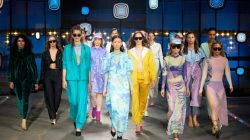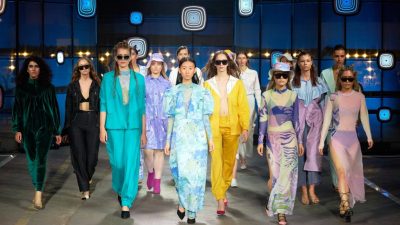Consumer Trends Shaping Online Purchases in Fashion and Accessories sets the stage for an exciting exploration of how modern shopping habits are transforming the fashion landscape. With more consumers turning to digital platforms, the online shopping experience is evolving into a dynamic arena influenced by technology, sustainability, and social media. Key demographics are reshaping how brands connect with shoppers, and understanding these trends is essential for both consumers and retailers alike.
From the rise of eco-conscious choices to the integration of augmented reality in online fitting rooms, the fashion industry is undergoing a seismic shift. Social media is not just a platform for sharing trends; it has become a pivotal factor in consumer decision-making, making it vital for brands to adapt. As globalization continues to blur cultural boundaries, the interplay between local and international fashion influences shapes a unique consumer experience.
Current Consumer Behavior in Fashion and Accessories
The fashion industry is experiencing a significant transformation as consumers increasingly turn to online shopping for their fashion and accessory needs. This shift is reshaping how brands connect with their audience and how consumers make their purchasing decisions. The rise in digital retail is not merely a trend; it represents a fundamental change in consumer behavior that is characterized by convenience, accessibility, and a broader selection of products.Key demographics are driving this online shopping trend, with millennials and Gen Z leading the charge.
These groups are not just comfortable with technology; they expect personalization and innovation in their shopping experiences. According to recent studies, over 75% of these consumers prefer shopping online for fashion items due to the ease of comparing products, reading reviews, and accessing exclusive online deals.
Impact of Social Media on Consumer Decision-Making
Social media plays a crucial role in influencing consumer choices in the fashion and accessories market. Platforms like Instagram, TikTok, and Pinterest serve as powerful tools for discovery and engagement, shaping trends and driving purchases. The visual nature of these platforms allows brands to showcase their products in creative ways, making fashion more accessible and relatable.The impact of social media can be quantified by examining the following points:
- Influencer Marketing: Brands collaborating with social media influencers can reach targeted audiences effectively. For example, a study indicated that 49% of consumers rely on influencer recommendations when purchasing fashion items.
- User-Generated Content: Consumers are more likely to trust peer reviews and posts showcasing real-life usage of products. This creates authenticity and builds brand loyalty.
- Visual Storytelling: The ability to tell a compelling brand story through images and videos enhances emotional connections with consumers, encouraging them to make purchases.
- Social Commerce: Integrated shopping features on platforms like Instagram and Facebook allow seamless transitions from discovery to purchase, simplifying the buying process for consumers.
“Over 70% of millennials are influenced by social media when making purchasing decisions in fashion.”
The connection between fashion brands and social media is not just about promotion; it’s about creating an immersive shopping experience that resonates with today’s consumers. This synergy is a driving force behind the continued growth of online shopping in the fashion sector, making it essential for brands to adapt and innovate in their digital marketing strategies.
Influences of Sustainability on Consumer Choices
As consumers become increasingly conscious of their environmental impact, sustainability has emerged as a pivotal factor influencing purchasing decisions in the fashion and accessories sector. With the rise of eco-awareness, shoppers are now prioritizing brands that align with their values, leading to a significant shift in market dynamics. This change not only reflects personal ethics but also reshapes the entire marketplace, compelling brands to rethink their production and marketing strategies.Sustainability trends are fundamentally altering consumer decision-making processes.
Shoppers are no longer merely attracted to aesthetics or trends; they are gravitating towards products that embody ethical sourcing, transparency, and a commitment to reducing waste. This shift is evident in the growing preference for materials such as organic cotton, recycled polyester, and other renewable resources that minimize environmental degradation. According to a recent study, over 66% of global consumers are willing to pay more for sustainable brands, highlighting a clear trend towards eco-conscious purchasing.
Rise of Eco-Friendly Brands in the Fashion Marketplace
The market has seen a remarkable uptick in eco-friendly brands that cater specifically to the growing demand for sustainable fashion. These brands not only focus on environmentally friendly materials but also emphasize ethical labor practices and fair trade. The appeal of these brands lies in their ability to provide stylish, high-quality products without compromising the planet’s health. Many consumers are actively seeking out brands that exemplify sustainability through their business practices and product offerings.
Notable examples include:
- PATAGONIA: Known for its commitment to environmental activism, Patagonia utilizes recycled materials in its products and donates a portion of profits to eco-friendly initiatives.
- EVERLANE: This brand prides itself on “radical transparency,” providing detailed information about its factories and the cost breakdown of each product, including labor and material expenses.
- REFORMATION: By focusing on sustainable fabrics and responsible manufacturing, Reformation has become a go-to brand for eco-conscious consumers looking for trendy styles.
- ALLBIRDS: Famed for its carbon-neutral shoes made from sustainable materials like merino wool and eucalyptus, Allbirds has positioned itself as a pioneer in eco-friendly footwear.
The emergence of these brands signifies a broader shift in consumer expectations regarding sustainable practices. Customers are increasingly holding brands accountable for their environmental footprint, seeking authenticity and commitment to sustainability rather than mere marketing gimmicks.
“Transparency and sustainability are no longer optional; they are essential for brands aiming to thrive in a competitive market.”
As consumers become more discerning, they expect brands to embrace sustainable practices, such as:
- Implementing circular economy models that promote recycling and upcycling.
- Reducing water usage and energy consumption in manufacturing processes.
- Offering clear information about sourcing and production methods.
- Engaging in carbon offsetting initiatives to mitigate environmental impact.
In summary, the trend towards sustainability is not just a fleeting fad; it is reshaping the landscape of fashion and accessories, challenging brands to innovate and adapt to meet the evolving expectations of the modern consumer. Brands that take proactive steps towards sustainability will not only enhance their reputation but also drive consumer loyalty in an ever-competitive marketplace.
The Role of Technology in Enhancing Online Shopping Experiences
As the online fashion and accessories market continues to grow, technology plays an essential role in shaping the shopping experience. Innovations such as augmented reality (AR), artificial intelligence (AI), and the rise of mobile applications are transforming how consumers interact with brands, making shopping more engaging, personalized, and convenient. This technological evolution is key to meeting the expectations of modern consumers who seek seamless and dynamic online experiences.
Augmented Reality Fitting Rooms
Augmented reality fitting rooms are revolutionizing the way consumers shop for clothing and accessories online. By using AR technology, retailers can provide virtual try-ons that allow shoppers to visualize how products will look on them without physically trying them on. This immersive experience not only enhances customer satisfaction but also reduces return rates, as consumers can make more informed choices.
Several brands have successfully implemented AR fitting rooms, creating a direct link between technology and consumer behavior. For instance, retailers like Warby Parker and Sephora offer virtual try-on features through their mobile applications. Customers can view how eyeglasses frame their faces or how lip colors complement their skin tones, all from the comfort of their homes. The excitement and interactivity of AR also encourage social sharing, further driving brand engagement.
Artificial Intelligence in Personalized Shopping Experiences
Artificial intelligence is at the forefront of creating personalized shopping experiences tailored to individual consumer preferences. AI-driven algorithms analyze user data, including browsing history, purchase behaviors, and social media interactions, to curate product recommendations that resonate with each shopper’s style and needs.
For example, brands like Stitch Fix use machine learning to understand customer tastes and preferences, enabling stylists to select items that fit perfectly with the user’s lifestyle. Furthermore, AI chatbots provide immediate assistance, answering queries and guiding users through their shopping journey, thus enhancing customer service and satisfaction. This personalized touch not only increases conversion rates but also fosters brand loyalty, as customers feel understood and valued.
Mobile Shopping Applications vs. Traditional E-commerce Websites
The rise of mobile shopping applications has significantly changed the landscape of online shopping. Mobile applications often provide a more streamlined and user-friendly experience compared to traditional e-commerce websites. They leverage device capabilities such as push notifications, camera features, and biometric authentication, allowing for quicker access and a more engaging shopping process.
Mobile apps are designed to enhance convenience and accessibility, often incorporating features like one-click purchasing, personalized content, and seamless integration with social media platforms. In contrast, traditional e-commerce websites may lack the intuitiveness and speed that consumers expect in today’s fast-paced digital environment. According to recent data, mobile commerce is projected to account for over 50% of all online retail sales by 2025, highlighting the growing importance of apps in the fashion and accessory market.
The shift towards mobile platforms is further emphasized by the success stories of brands that prioritize app development. For instance, ASOS and Zara have launched highly rated mobile applications that not only facilitate shopping but also engage users with interactive content and exclusive promotions, cementing their place in a competitive market.
The Impact of Globalization on Fashion Consumption
Globalization has revolutionized the fashion industry, allowing the swift exchange of trends and styles across borders. As consumers become more interconnected, the influence of international fashion trends on local markets has become increasingly notable. The accessibility of diverse styles has created a vibrant marketplace where cultural influences shape individual tastes and preferences.
Influence of International Trends on Local Markets
The influx of global fashion trends significantly impacts local markets, reshaping consumer choices and preferences. International designers and brands have introduced styles that often resonate with local consumers, leading to a blending of traditional and contemporary fashion. This phenomenon can be seen in how local fashion houses adopt global styles while infusing them with regional characteristics, creating unique hybrid looks that reflect both global and local aesthetics.
- Adaptation of Global Styles: Local designers frequently interpret international trends to suit regional tastes, resulting in a fusion of styles that cater to diverse consumer bases.
- Brand Influence: Recognizable international brands set trends that local markets strive to emulate, often leading to shifts in consumer purchasing behavior toward these global names.
- Increased Variety: Globalization offers consumers access to a wider array of styles and brands, enhancing their choices and encouraging experimentation with new looks.
Effects of Cross-Border Shopping on Consumer Behavior
Cross-border shopping has become commonplace in the digital age, driven by the convenience of online platforms that allow consumers to purchase from international retailers with ease. This trend has significantly altered consumer behavior in several ways, as individuals seek the latest fashion offerings from around the globe.
- Price Competition: Consumers often shop internationally to capitalize on better pricing, driving local retailers to reassess their pricing strategies.
- Enhanced Product Availability: Access to international brands means consumers can find specific items that may not be available locally, fostering a desire for unique, hard-to-find products.
- Influence of Reviews and Trends: Online reviews and social media have amplified the impact of global trends on local consumers, as individuals look to influencers and online communities for guidance on their purchases.
Role of Cultural Exchange in Fashion Accessibility
Cultural exchange plays a crucial role in enhancing fashion accessibility, allowing consumers to engage with varying styles and traditions from different parts of the world. This intersection of cultures has resulted in a more informed consumer base that appreciates the stories and histories behind fashion pieces.
- Promotion of Diversity: Cultural exchange fosters an appreciation for diverse fashion narratives, leading to a richer understanding of style and identity.
- Collaborative Collections: Many brands are now partnering with international designers to create collaborations that celebrate cultural heritage, allowing for authentic representation and wider appeal.
- Empowerment through Knowledge: Consumers are increasingly educated about the origins of their fashion choices, leading to more conscious shopping habits that respect cultural significance.
The Importance of Brand Loyalty in Online Fashion Purchases: Consumer Trends Shaping Online Purchases In Fashion And Accessories
In today’s fast-paced online shopping environment, brand loyalty plays a crucial role in influencing consumer behavior, particularly in the fashion and accessories sector. As consumers are bombarded with numerous options, the ability of brands to cultivate loyalty can significantly enhance customer retention and drive repeat purchases. Loyalty programs, effective strategies, and compelling brand storytelling are essential elements that contribute to building strong connections with consumers.Loyalty programs are an effective way to influence consumer retention, encouraging repeat business through incentives that resonate with customers.
These programs often include rewards such as discounts, exclusive access to new collections, and personalized offers based on shopping behavior. By providing customers with tangible benefits, brands can foster a sense of belonging and appreciation, ultimately enhancing their shopping experience. The cornerstones of successful loyalty programs include:
- Tiered rewards systems that motivate customers to reach higher spending levels for better rewards.
- Exclusive member-only sales events that create urgency and excitement around purchasing.
- Personalized communications that tailor marketing messages and product recommendations to individual preferences.
Strategies for Building Loyalty Online
Brands leverage various strategies to enhance customer loyalty in the digital marketplace, ensuring that consumers remain engaged and committed to their brand. These strategies often focus on creating memorable experiences that resonate with consumers on a personal level. Key tactics include:
- Consistent and high-quality customer service that addresses inquiries and resolves issues promptly.
- Engaging social media presence that fosters community interactions and showcases user-generated content.
- Exclusive content, such as styling tips or behind-the-scenes looks at the brand’s design process, that entertains and informs customers.
Brand storytelling is fundamental in establishing emotional connections with consumers, allowing brands to differentiate themselves in a crowded market. Effective storytelling humanizes the brand and creates relatable narratives that resonate with consumers’ values and aspirations. Some effective storytelling techniques include:
- Sharing the brand’s origin story, which highlights its mission, vision, and values, creating a sense of authenticity.
- Highlighting customer testimonials and success stories that illustrate the positive impact of the brand on people’s lives.
- Creating visually appealing content that showcases the products in real-life scenarios, helping consumers envision their lifestyle with the brand.
“Brand loyalty is built through meaningful connections that resonate with consumers, elevating their shopping experience beyond mere transactions.”
Consumer Trends in Fashion Influenced by Economic Factors

Economic fluctuations significantly shape consumer behavior in the fashion industry. During economic downturns, consumers often reevaluate their spending habits, leading to more cautious purchasing decisions. Understanding these shifts is crucial for fashion brands aiming to align their strategies with current market conditions and consumer preferences.One notable trend during economic downturns is the rise of affordable luxury brands. As consumers face financial constraints, they tend to gravitate towards brands that offer a sense of luxury without the exorbitant price tag.
This shift reflects a desire to indulge in quality and style while maintaining budgetary discipline. As a result, many brands have successfully positioned themselves as providers of ‘affordable luxury,’ appealing to both aspirational buyers and those seeking value.
Consumer Responses to Pricing Strategies and Promotions
During challenging economic times, consumer responses to pricing strategies and promotions become more pronounced. Brands that effectively cater to these shifts can enhance their appeal and maintain customer loyalty. Several key points highlight how consumers react to pricing in the fashion sector:
- Price Sensitivity: Consumers become increasingly price-sensitive during economic downturns. They actively seek discounts, promotions, and value-for-money offerings, prompting brands to adjust their pricing strategies accordingly.
- Promotional Campaigns: Targeted promotions and sales events can significantly influence consumer purchasing decisions. Brands that strategically time their promotions often see an uptick in sales, as consumers look to capitalize on savings.
- Perceived Value: The perception of value plays a critical role. Brands that communicate quality alongside affordability can attract more buyers, even during financially challenging periods.
- Brand Loyalty: While price is a determining factor, brand loyalty remains essential. Consumers often stick to familiar brands, especially if they feel they are receiving good value for their money.
- Shift to Essentials: During economic strain, consumers prioritize essential fashion items over luxury or trend-driven purchases. Brands that focus on timeless, versatile pieces tend to fare better.
“In times of economic uncertainty, consumers’ desire for quality and affordability shapes their fashion choices, leading to a significant shift toward brands that can effectively meet these needs.”
These insights underscore the importance of adaptability in pricing and promotional strategies for fashion brands aiming to thrive in an ever-evolving economic landscape.
The Rise of Influencer Marketing in Fashion
The fashion industry has undergone a significant transformation with the rise of influencer marketing, where personalities with substantial social media followings have become integral to brands’ promotional strategies. This shift has redefined how fashion labels connect with consumers, emphasizing authenticity and relatability over traditional advertising methods. As influencers curate their personal brands, they provide a unique platform for fashion brands to engage with target audiences in a more personalized manner.Influencer partnerships have proven to be highly effective, creating a direct line of communication between brands and consumers.
Through collaborations with influencers, fashion brands can leverage their reach to effectively promote products while simultaneously enhancing their brand image. The engagement generated through influencer campaigns often surpasses traditional advertising metrics, allowing brands to achieve a higher return on investment.
Impact of Micro-Influencers Compared to Major Celebrities
The influence of micro-influencers—those with smaller but highly engaged followings—compared to major celebrities, has gained significant attention. Micro-influencers tend to foster closer connections with their audiences, leading to increased authenticity and trust. Their content often reflects genuine personal experiences with products, which resonates deeply with consumers.Key points illustrating the efficacy of micro-influencers include:
- Higher Engagement Rates: Micro-influencers often achieve engagement rates of 3-10%, substantially higher than the 1-3% typically seen with major celebrities.
- Targeted Niche Audiences: They cater to specific interests and demographics, allowing brands to reach targeted consumer segments effectively.
- Cost-Effective Collaborations: Partnering with micro-influencers is frequently more affordable, enabling brands to allocate their budgets across multiple influencers for broader reach.
The marketing dynamics shift as brands recognize that the power of influence is not solely determined by follower count, but rather by the depth of connection between the influencer and their audience. This strategic pivot has led to the emergence of micro-influencer campaigns that yield strong results in terms of brand awareness and sales.
Influencer Marketing Shapes Brand Perception and Consumer Trust
Influencer marketing plays a crucial role in shaping brand perception, as influencers act as intermediaries who communicate brand values and narratives to their followers. The credibility associated with influencers directly impacts how consumers perceive brands they promote.Factors that contribute to this dynamic include:
- Authentic Storytelling: Influencers share personal stories and experiences related to the brands, creating emotional connections that traditional ads often lack.
- Social Proof: When consumers see their favorite influencers using or endorsing a product, they are more likely to trust and consider that brand, leading to increased credibility.
- Community Building: Influencers foster communities around brands, encouraging dialogue and interactions that enhance consumer loyalty and brand affinity.
In summary, the rise of influencer marketing in fashion has redefined consumer engagement and trust. As brands continue to adapt their strategies, the influence of both micro-influencers and major celebrities remains pivotal in shaping the future of fashion consumption.
Future Predictions for Online Fashion Purchasing Trends
As we look towards the future, the landscape of online fashion purchasing is poised for significant transformation. Emerging technologies and consumer behaviors will redefine how individuals engage with fashion brands and make purchasing decisions. This analysis delves into the upcoming trends that are likely to shape online fashion and the integration of advanced technologies that enhance shopping experiences.
Emerging Trends in Online Fashion
Several key trends are anticipated to influence the online fashion marketplace significantly. Understanding these trends is crucial for brands looking to stay ahead of the competition.
- Personalization through AI: Brands are increasingly using artificial intelligence to create tailored shopping experiences. AI algorithms analyze consumer behavior, suggesting items based on past purchases and preferences, thereby enhancing customer satisfaction.
- Social Commerce Growth: The fusion of social media and e-commerce continues to rise, allowing users to shop directly from platforms like Instagram and TikTok. This trend leverages peer influence and engages consumers in a familiar digital environment.
- Sustainable Practices: Consumers are becoming more conscious of their fashion choices, favoring brands that prioritize sustainability. Companies are expected to adopt eco-friendly materials and transparent supply chains to attract environmentally aware shoppers.
- Subscription Models: The convenience of subscription services is appealing to consumers. Fashion brands are likely to explore this model, offering curated boxes that align with personal style and preferences, encouraging long-term customer loyalty.
Impact of Virtual Reality on Shopping Experiences, Consumer Trends Shaping Online Purchases in Fashion and Accessories
Virtual reality (VR) is set to revolutionize online shopping by offering immersive experiences that traditional platforms cannot match. This technology allows consumers to engage with fashion products in a virtual space, simulating an in-store experience from the comfort of their homes.Through VR, customers can explore virtual showrooms, visualize how clothing fits on avatars that resemble their body types, and even interact with other shoppers in a digital environment.
This capability not only enhances the shopping experience but also reduces the uncertainty associated with online purchases, leading to lower return rates.
“Virtual reality provides a bridge between online shopping and the tactile experience of traditional retail, allowing consumers to make informed decisions.”
Evolution of Consumer Preferences with Technology Advancements
As technology evolves, so do consumer expectations and preferences. Today’s digital-savvy shoppers prioritize convenience, speed, and engagement in their online shopping experiences. Here’s how these preferences may evolve:
- Instant Gratification: With advancements in logistics, consumers expect faster shipping options. Brands that offer same-day delivery or automated fulfillment processes are likely to see increased customer retention.
- Enhanced Visual Shopping: Innovations like augmented reality (AR) allow consumers to visualize products in their own environments, further embedding technology into the shopping process.
- Voice-Activated Shopping: As smart devices become commonplace, consumers will likely shift towards voice-activated shopping, allowing them to make purchases hands-free and seamlessly.
- Data Privacy Concerns: As brands rely more on consumer data for personalization, maintaining transparency and protecting user information will be essential to building trust and ensuring long-term customer relationships.
By embracing these emerging trends, fashion brands can position themselves to thrive in the rapidly changing e-commerce landscape, ensuring they meet the dynamic needs of future consumers.















